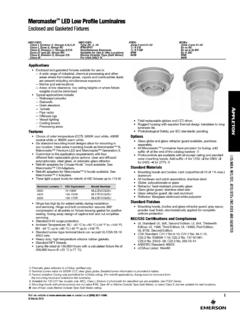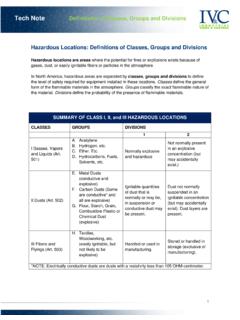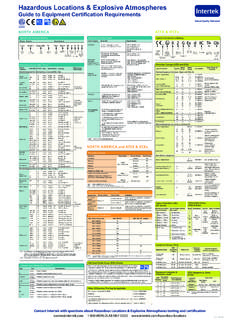Transcription of Guide for hazardous areas - Autrosafe oy
1 Guide for hazardous areas 1 hazardous areas definitions 2 as and dust groups G. 3 emperature classifications T. 4 ommon flammable gases, vapours and dust types C. 5 Protection concepts ATEX and IECEx 6 rotection concepts North America and Canada P. 7 I P Ratings and NEMA enclosure types 8 able gland selection for Ex d equipment C. 9 ypical equipment marking and references T. 10 E 2S signals, loudspeakers and callpoints hazardous areas definitions 1. hazardous areas according to ATEX and IECEx zones hazardous locations according to North American classes and divisions Zones - define the type of explosive atmosphere as well as the Classes - define the type of explosive atmosphere.
2 Likelihood of an explosive atmosphere being present I - A location made hazardous by the presence of flammable gas 0 - E xplosive gas atmosphere present continuously or for long periods or vapor that may be present in the air in quantities sufficient 1 - Explosive gas atmosphere likely to occur in normal operation to produce an explosive or ignitable mixture 2 - Explosive gas atmosphere not likely to occur in normal operation II - A location made hazardous by the presence of combustible or but may be present for short periods electrically conductive dust 20 - Explosive dust atmosphere present continuously or for long periods III - A location made hazardous by the presence of easily ignitable 21 - Explosive dust atmosphere likely to occur in normal operation fibers or flyings in the air.
3 But not likely to be in suspension in 22 - Explosive dust atmosphere not likely to occur in normal quantities sufficient to produce ignitable mixtures operation but may be present for short periods Divisions - define the likelihood of an explosive atmosphere being present 1 - A location where a classified hazard exists or is likely to exist under normal conditions 2 - A location where a classified hazard does not normally exist but is possible to appear under abnormal conditions In Canada new installations must now use the ATEX / IECEx system of In the USA, all installations can use either the class / Zone Zones instead of Divisions.
4 Existing installations may use either system. or the class / Division system. ATEX ATEX equipment Zone Required class / Zone class / Division equipment category and classification equipment classification classification group environment type ATEX / IECEx protection US / Canada US / Canada level (EPL). M1 Ma I N/A N/A Mining M2 Mb 1G Zone 0 Ga class I, Zone 0. class I, Division 1. 2G Zone 1 Gb class I, Zone 1. 3G Zone 2 Gc class I, Zone 2 class I Division 2. II. 1D Zone 20 Da class II, Zone 20. class II, Division 1. 2D Zone 21 Db class II, Zone 21.
5 3D Zone 22 Dc class II, Zone 22 class II, Division 2, class III. Gas and dust groups 2. ATEX, IECEx and US / Canada zones system US / Canada class / division system Gas / dust Typical substances Gas / dust Typical substances group group IIC Acetylene class I, Group A Acetylene IIB + H2 Hydrogen class I, Group B Hydrogen IIB Ethylene class I, Group C Ethylene IIA Propane class I, Group D Propane IIIC Conductive Dust class II, Group E combustible Metal Dust class II, Group F combustible carbonaceous dust IIIB Non-conductive Dust class II, Group G combustible dusts not in group E or F.
6 IIIA combustible Flyings class III combustible fibres and flyings Temperature classifications 3. Group II & III class I, II & III. Maximum Temperature Ignition tem- Maximum Temperature Ignition surface class perature of surface class temperature temperature of gas/dust ( C) C temperature of of gas/dust equipment ( C) equipment ( C) ( C). 450 T1 >450 450 450 450 T1 >450. 300 T2 >300 - 450 300 T2 >300 - 450. 280 T2A >280 - 300. 260 T2B >260 - 280. 300 230 T2C >230 - 260. 260 215 T2D >215 - 230. 200 T3 >200 - 300 200 T3 >200 - 215. 200 230 180 T3A >180 - 200.
7 165. 165 T3B >165 - 180. 135. 120 160 T3C >160 - 165. 135 T4 >135 - 200 85 135 T4 >135 - 160. 100. 120 T4A >120 - 135. 100 T5 >100 - 135 100 T5 >100 - 120. 85 T6 >85 - 100 85 T6 >85 - 100. Note: For Group I mining applications, apparatus has rigid 150 C coal dust and 450 C methane limits rather than T classes. Common flammable gases, vapours and dust types 4. Gas vapour Temper- Appa- Typical Dusts Apparatus Typical Typical ature ratus ignition group ignition ignition class group tempera- temperature temperature ture ( C) cloud ( C) layer ( C). Acetic acid T1 llA 427 Aluminium IIIC 590 >450.
8 Acetone T1 llA 465 Coal dust (lignite) IIIB 380 225. Acetylene T2 llC 305 Flour IIIB 490 340. Ammonia T1 llA 651 Grain dust IIIB 510 300. Butane T2 llA 405 Methyl cellulose IIIB 420 320. Carbon Disulphide T6 IIC 95 Phenolic resin IIIB 530 >450. Cyclohexane T3 llA 245 Polythene IIIB 420 (melts). Di-ethyl ether T4 llB 160 PVC IIIB 700 >450. Ethanol (ethyl alcohol) T2 llA 365 Soot IIIB 810 570. Ethylene T2 llB 490 Starch IIIB 460 435. Gasoline (petrol) T3 llA 280 Sugar IIIB 490 460. Hydrogen T1 llC 500. Kerosene T3 llA 295 Gas Groups Methane (natural gas) (non-mining) T1 llA 580 IIA Propane Methanol (methyl alcohol) T2 llA 470 IIB Ethylene Methyl ethyl ketone (MEK) T2 llB 505 IIC Hydrogen/Acetylene Propane T1 llA 470 Dust Groups Propan-1-ol (n-propyl alcohol) T2 llB 371 IIIA combustible Propan-2-ol (iso-propyl alcohol) T2 llA 399 IIIB Non-conductive Toluene T1 llA 535 IIIC Conductive Xylene T1 llA 463.
9 Protection concepts ATEX and IECEx 5. Symbol Type of protection Basic concept of protection Suitable for Typical EPL EN / IEC. Zones Standard 0 1 2 20 21 22 Ga Gb Gc Da Db Dc e Increased safety No arcs, sparks or hot surfaces, 60079-7. Type n' (non sparking) enclosure IP54 or better . n Type n' (closed-break) Containment of the explosion 60079-15. Type n' (sealed and hermetically sealed). Keep the flammable substance out . Type n' (restricted breathing) . d Flameproof Containment of the explosion 60079-1. q Powder filled Quenching of the flame 60079-5.
10 Ia . Limitation of spark energy and ib Intrinsic safety surface temperatures 60079-11. ic . px . py Pressurised enclosure 60079-2. pz . ma Keep the flammable substance out . mb Encapsulation 60079-18. mc . o Oil immersion 60079-6. Op pr . Inherently safe, protected by Op sh Optical radiation shutdown 60079-28. Op is . ta . Dust ignition protection tb by enclosure Dust-tight enclosure 60079-31. tc . pd Pressurised enclosure Keep the flammable substance out 61241-4.. Protection concepts North America and Canada 6. Electrical equipment for flammable gases, vapors and mist US CAN Type of Basic concept class I Div class I Zone US Standard CA Standard code code protection of protection 1 2 0 1 2.






